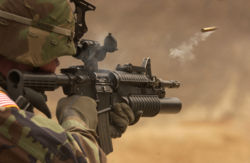Army: Difference between revisions
imported>Gareth Leng mNo edit summary |
imported>Meg Taylor No edit summary |
||
| Line 1: | Line 1: | ||
{{subpages}} | {{subpages}} | ||
[[Image:Casing.jpg|thumb|250px| A U.S. Army soldier firing a 5.56 mm round from an M4 rifle (the M4 also has an M203 40mm Grenade Launcher attached).]]An '''Army''' is a term either referring to one of the largest types of [[Formation (ground military forces)|formation]] for a land-based military force, or the entirety of a nation's military force responsible for its land defenses, both of which are composed of [[Soldier|soldiers]], trained to engage in [[war]]. | [[Image:Casing.jpg|thumb|250px| A U.S. Army soldier firing a 5.56 mm round from an M4 rifle (the M4 also has an M203 40mm Grenade Launcher attached).]]An '''Army''' is a term either referring to one of the largest types of [[Formation (ground military forces)|formation]] for a land-based military force, or the entirety of a nation's military force responsible for its land defenses, both of which are composed of [[Soldier|soldiers]], trained to engage in [[war]]. | ||
An army, as a single in-theater force, operates at a [[military doctrine#Strategy|strategic]] level, but is composed of smaller operational units which operate | An army, as a single in-theater force, operates at a [[military doctrine#Strategy|strategic]] level, but is composed of smaller operational units which operate at the level of [[military doctrine#Operational art|operational art]] or [[military doctrine#tactics|tactics]]. | ||
In modern warfare, a '''field army''' is an [[echelons above corps|echelon above corps]], but usually more an administrative than operational headquarters. It is unlikely that multiple field armies will ever be in battle, but, in the Second World War, '''army groups''' were operational headquarters for multiple field armies. | In modern warfare, a '''field army''' is an [[echelons above corps|echelon above corps]], but usually more an administrative than operational headquarters. It is unlikely that multiple field armies will ever be in battle, but, in the Second World War, '''army groups''' were operational headquarters for multiple field armies. | ||
| Line 12: | Line 11: | ||
==References== | ==References== | ||
{{reflist}} | |||
Revision as of 02:15, 29 October 2013
An Army is a term either referring to one of the largest types of formation for a land-based military force, or the entirety of a nation's military force responsible for its land defenses, both of which are composed of soldiers, trained to engage in war.
An army, as a single in-theater force, operates at a strategic level, but is composed of smaller operational units which operate at the level of operational art or tactics.
In modern warfare, a field army is an echelon above corps, but usually more an administrative than operational headquarters. It is unlikely that multiple field armies will ever be in battle, but, in the Second World War, army groups were operational headquarters for multiple field armies.
Not all countries use "army" to indicate the same level of command. Western practice is that a field army is made up of two or more corps, and is commanded by a full general or lieutenant general. WWII Japanese "armies" were of several levels; an unqualified "army" was equivalent to a Western corps, an "area army" to a field army, and a "general army" to an army group.
Armies are most commonly numbered, with the designation written out Third United States Army or First Canadian Army. The Japanese Kwantung Army was actually at army group/theater level. Some countries use honorific, branch, or both in their army names, such as the Soviet First Guards Army or Sixth Guards Tank Army.
